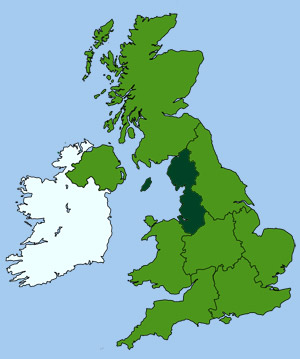Barrow-in-Furness
Barrow is an old Victorian industrial settlement located on the western tip of a wide peninsula that juts out into Morecambe Bay. This old ship-building town has extensive docks and quays where naval ships, including Britain's nuclear submarines, were built.
Long before shipbuilding the town was know for its powerful Furness Abbey, a 12th-c Cistercian foundation situated to the north-east of the town.
The main thoroughfare (Abbey Road) is a long, wide, tree-lined street leading to Ramsden Square, where the town library and community hub can be found. An impressive red-stone Victorian Town Hall stands in Duke Street. Opposite to this is the more modern Civic hall, where regular concerts and social events take place.
A bridge from the town leads to the long thin Walney Island; parts of which have been designated as a Nature Reserve. A beautiful 12 mile stretch of sandy beaches reach along the island's west coast, backed by dunes.
Places to Visit in Barrow-in-Furness
The Dock Museum
An interesting modern museum built over an original Victorian dock. On display are several impressive model ships with interactive displays. The museum also has artefacts and discoveries from Prehistoric, Roman and Viking periods, right up to both world wars and exhibits on local shipbuilding.
Opening times: Wednesday to Sunday, 11am to 4pm - Free Entry
Location: North Road, Barrow-in-Furness LA14 2PW
Tel: 01229 876400
Website: dockmuseum.org.uk
Piel Castle
The ruins of a 14th-c castle located on the south-eastern point of Piel Island, just off the coast. The fortress was constructed by the Abbot of Furness to defend the town's southern approaches. The castle can only be accessed from Roa Island via a small ferry operated during the spring and summer season.
Location: Piel Castle, Barrow-in-Furness, Piel Island LA13 0QN
Tel: 0800 015 0516
Website: english-heritage.org.uk
Furness Abbey

The magnificent red-sandstone ruins of Furness Abbey can be seen in a wooded valley a few miles north-east of the town. Founded in 1123 by Count Stephen (later King Stephen of England) it eventually grew to become one of the most important ecclesiastical centres in the north.
Much of the abbey still survives giving a fine impression of its once grand scale. Remains include a 200ft long dormitory, a 150ft refectory, plus large sections of the church tower, walls and other architecture. A small chapel attached to the infirmary contains two 13th-c effigies of knights in armour, believed to be some the oldest surviving of their kind. A small exhibition provides a good introduction to Cistercian monastic life at Furness.
Opening times: daily, 10am to 5pm - Admission Charge
Location: Manor Rd, Barrow-in-Furness LA13 0PJ
Tel: 0370 333 1181
Website: english-heritage.org.uk
Map of Barrow-in-Furness
North West England


